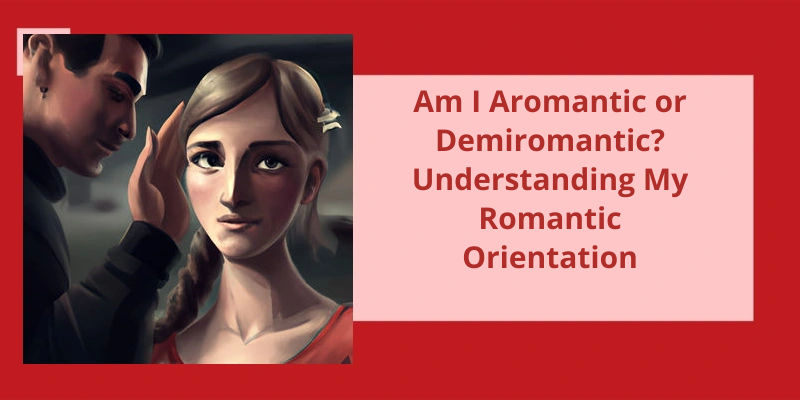As human beings, we all experience a wide range of emotions, some of which are deeply rooted in our romantic relationships. However, for some individuals, this aspect of emotional connection may not hold the same level of significance as others. These individuals identify as either aromantic or demiromantic, two distinct orientations that offer an alternative perspective on the nature of romantic attraction. While aromantics experience no attraction towards anyone, individuals who identify as demiromantic occasionally feel such a connection, but only after a strong emotional bond has been formed. Deciding where you stand on the spectrum of romantic attraction can undoubtedly be a challenging journey, but it's an essential step towards gaining a deeper understanding of yourself and your emotional needs. If you're questioning whether you're aromantic or demiromantic, it's essential to take the time to explore and analyze your feelings in a safe, non-judgmental environment.
Can You Be Aromantic and Demiromantic?
When it comes to romantic attraction and sexuality, there’s no one-size-fits-all approach. Each individual has their own unique feelings and experiences, and this is especially true when it comes to the aromantic and demiromantic spectrums.
Aromanticism is a term used to describe individuals who don’t feel any romantic attraction to anyone. This doesn’t mean that they don’t form close bonds or connections with others, but rather that those connections aren’t rooted in romantic feelings. For some, their lack of romantic attraction is a defining part of their identity, and they may refer to themselves as “aro” for short.
Demiromanticism, on the other hand, is a term used to describe individuals who occasionally feel romantic attraction, but only after forming a deep and meaningful connection with someone else. This is similar to the way that demisexual individuals experience sexual attraction only after forming a strong emotional bond with someone else.
While the aromantic and demiromantic spectrums are still being explored and understood, it’s clear that these individuals are just as valid and worthy of love and respect as anyone else. It’s important for society to continue to acknowledge and accept the diversity of experiences and identities when it comes to romantic attraction and sexuality, and to create safe spaces for all individuals to express themselves without fear of judgment or discrimination.
The Experiences and Challenges Faced by Aromantic and Demiromantic Individuals in Romantic Relationships and Dating
This topic explores the unique experiences and difficulties that those who identify as aromantic or demiromantic face when trying to navigate romantic relationships and dating.
Understanding one’s romantic orientation can be an important step in self-discovery and building healthy relationships. While there are many different romantic orientations, one that’s gaining more recognition in recent years is demiromanticism. If you’re wondering if you might be demiromantic, there are a few key traits and experiences to look out for.
How Do You Know if You Are Demiromantic?
There isn’t a set list of criteria that definitively determines whether someone is demiromantic or not, as it’s a nuanced and personal experience. However, some common signs of being demiromantic may include feeling disconnected or disinterested in typical romantic encounters, struggling to feel attraction without first establishing a deep emotional bond, and feeling a strong desire for emotional intimacy in relationships.
Demiromanticism is sometimes mistaken for asexuality, as demiromantic individuals may not experience attraction to others in a traditional sense until they’ve developed an emotional connection.
It’s important to note that being demiromantic isn’t something that can be changed or controlled, and it’s just one aspect of a persons identity. Demiromantic individuals may find that they’ve difficulty navigating traditional dating and relationship styles, but there are alternative approaches and communities that can provide support and understanding.
Consider talking to others who identify as demiromantic or seeking out resources online to learn more about the experiences of others. Ultimately, only you can determine how you identify and what feels authentic to you. The most important thing is to approach your identity with kindness and self-acceptance.
Differences Between Demiromanticism and Other Forms of Romantic Orientation
- Demiromanticism is a romantic orientation where a person only experiences romantic attraction after forming a strong emotional connection with someone, while other forms of romantic orientation don’t have this requirement.
- Demisexualism, also known as demi-sexuality, is a sexual orientation where a person only experiences sexual attraction after forming a strong emotional connection with someone, while other forms of sexuality don’t have this requirement.
- Aromanticism is a romantic orientation where a person doesn’t experience romantic attraction, while other forms of romantic orientation do.
- Allosexualism, also known as allosexuality, is a sexual orientation where a person experiences sexual attraction to others, while asexualism is a sexual orientation where a person doesn’t experience sexual attraction.
- Bisexuality is a romantic and/or sexual orientation where a person is attracted to people of more than one gender, while other romantic and/or sexual orientation don’t have this attraction to multiple genders.
- Pansexuality is a romantic and/or sexual orientation where a person is attracted to people regardless of their gender or sexual orientation, while other romantic and/or sexual orientation have a preference for a specific gender or sexual orientation.
Conclusion
In conclusion, figuring out one's romantic orientation can be a complex and ongoing journey. It’s important to remember that there’s no right or wrong way to identify, and individuals should feel empowered to explore and embrace their own unique experiences and feelings. Whether one identifies as aromantic, demiromantic, or falls somewhere in between, what truly matters is understanding oneself and finding partners who respect and appreciate all aspects of who we are. It’s through this self-discovery that we can foster fulfilling and meaningful relationships, wherever the spectrum of romantic attraction may lie.






